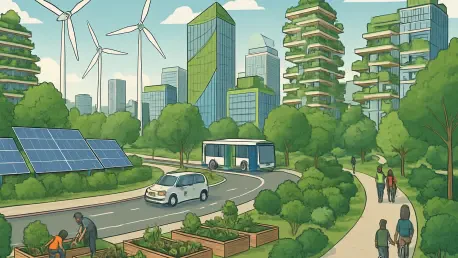As urban centers across Canada grapple with the pressing challenges of climate change and rapid population growth, two cities stand out as pioneers in redefining what sustainable living can look like. Calgary and Vancouver, with their distinct cultural and economic landscapes, are carving unique paths toward environmentally conscious urban development. These cities are not just responding to immediate needs but are setting a precedent for how Canadian municipalities can balance ecological responsibility with the demands of modern life. Through innovative strategies and forward-thinking policies, they offer valuable lessons on integrating affordability, design, and human well-being into the fabric of urban planning. This exploration delves into the specific approaches of each city, highlighting their contributions to a broader vision of sustainability that could inspire other regions to follow suit.
Urban Innovation in Canadian Cities
Calgary’s Pragmatic Push for Green Solutions
In Calgary, sustainability takes on a distinctly practical tone, driven by the city’s deep-rooted entrepreneurial mindset and a focus on economic viability. The construction sector here prioritizes cost control and scalability, ensuring that green practices are not just idealistic goals but feasible solutions for widespread adoption. Zero-carbon construction methods have gained traction, largely because they promise long-term savings for businesses and homeowners alike. This approach demystifies sustainable building by aligning it with financial benefits, making it an attractive option for a diverse range of stakeholders. By embedding affordability into eco-friendly initiatives, Calgary demonstrates that environmental responsibility does not have to come at a prohibitive cost, setting a compelling example for other cities aiming to make green living accessible to all.
Beyond the economic incentives, Calgary’s strategy also emphasizes simplicity and efficiency in implementation. The city’s developers and policymakers work to streamline processes, reducing bureaucratic hurdles that often slow down sustainable projects. This focus on straightforward execution ensures that initiatives like energy-efficient retrofitting of existing structures can be rolled out quickly and effectively. Additionally, there is a growing recognition of the importance of community buy-in, with local campaigns educating residents on the tangible benefits of adopting green technologies. Such efforts foster a culture of participation, where sustainability becomes a shared goal rather than a top-down mandate, further solidifying Calgary’s position as a leader in pragmatic urban innovation.
Vancouver’s Ambitious Design-Driven Approach
Vancouver, on the other hand, positions itself as a laboratory for cutting-edge, design-focused sustainability that goes beyond mere compliance with regulations. Guided by stringent frameworks like the BC Energy Step Code, the city integrates energy efficiency into building designs while prioritizing elements that enhance residents’ quality of life, such as natural lighting and ergonomic layouts. This holistic perspective redefines success, measuring it not just in reduced carbon footprints but in the tangible improvements to occupants’ daily experiences. Vancouver’s commitment to blending environmental goals with human-centric design showcases how urban spaces can be both eco-friendly and enriching, offering a model that challenges other cities to elevate their ambitions.
Moreover, Vancouver’s approach is deeply rooted in fostering psychological well-being through architecture. Buildings are crafted to create environments that reduce stress and promote health, incorporating green spaces and biophilic elements that connect residents with nature. This focus on mental and emotional health sets the city apart, as it recognizes that sustainability extends beyond physical structures to the lived experiences of individuals. Policymakers and designers collaborate closely to ensure that these principles are embedded in every project, creating a ripple effect that influences urban planning on a broader scale. Vancouver’s bold vision serves as a reminder that sustainable cities must nurture both the planet and the people who inhabit them.
A Vision for Sustainable Urban Futures
Blending Affordability with High-Ambition Design
The complementary strategies of Calgary and Vancouver suggest a powerful blueprint for sustainable urban development across Canada, one that merges cost-effective scalability with visionary design principles. Calgary’s emphasis on affordability ensures that green solutions are within reach for a wide audience, preventing sustainability from becoming an elite privilege. Meanwhile, Vancouver’s dedication to innovative, people-oriented planning raises the bar for what urban living can achieve in terms of wellness and environmental impact. By combining these strengths, Canadian cities could address immediate housing and ecological needs while laying the groundwork for long-term resilience, creating urban centers that are both practical and inspiring.
This convergence also highlights the importance of adaptability in urban planning. As populations grow and climate challenges intensify, cities must be equipped to evolve, using flexible frameworks that incorporate both economic pragmatism and forward-thinking creativity. Lessons from Calgary and Vancouver underscore the value of tailoring solutions to local contexts while maintaining a shared commitment to sustainability goals. This balanced approach could serve as a catalyst for national policies that encourage collaboration between municipalities, ensuring that the benefits of sustainable development are felt across diverse communities, regardless of their unique challenges or resources.
Building Communities for Tomorrow
Reflecting on the strides made by Calgary and Vancouver, it becomes clear that the journey toward sustainable cities demands a thoughtful integration of economic, environmental, and social priorities. Both cities tackled their unique challenges with tailored solutions, proving that localized strategies could contribute to a cohesive national vision. Their efforts showed that sustainability was not a one-size-fits-all endeavor but a dynamic process requiring constant innovation and community engagement. Looking back, their pioneering work laid a foundation for healthier, more adaptable urban environments that prioritized both planetary health and human well-being.
Moving forward, the focus should shift to scaling these successes through cross-city partnerships and knowledge-sharing initiatives. Encouraging dialogue between urban planners, policymakers, and residents can help refine these models, ensuring they remain relevant amid evolving global pressures. Investing in education and training for professionals who bridge practical construction with creative design will also be crucial. Ultimately, the legacy of Calgary and Vancouver can inspire a collective push toward urban centers that not only meet current demands but also anticipate future needs with ingenuity and care.









